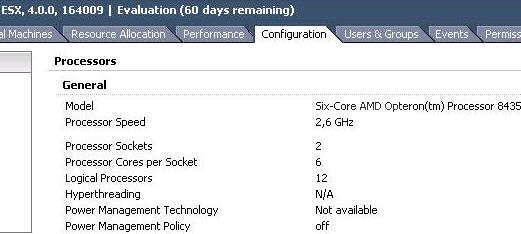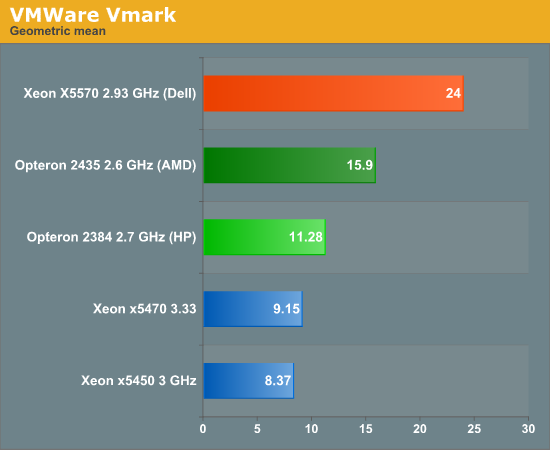Virtualization: To Be or Not to Be
Let there be no misunderstanding: how well a new Server CPU handles virtualization determines whether it is a wallflower or a blockbuster. Thanks to the superb feedback we got on our first attempt, we have continued to refine vApus Mark I. We are very happy that despite the insane timing, we managed to pull off both 4 VM and 8 VM on ESX 3.5 update 4 and ESX 4.0 (vSphere 4 build 164009). Since it is by far the most important market for the new six-core, we decided to spend most of our time and energy here.

We have two benchmarks for you: VMmark and vApus Mark I. VMmark – which we discussed in great detail here - tries to measure a typical consolidation workload: a combination of a light mailserver, database, fileserver, website with a somewhat heavier java application. One VM is just sitting idle, representative of workloads that have to be online but which perform very little work (for example, a domain controller). In short, VMmark goes for the scenario where you want to consolidate lots and lots of smaller apps on one physical server.
There are no official VMmark scores yet, but a backup slide of AMD’s presentation talked about 41% performance increase over the Opteron 2384, a “Shanghai” Opteron at 2.7 GHz. We can use that number to get a first, very unofficial idea where a dual six-core 2435 at 2.6 GHz will land. The best score for the quad-core Opteron is 11.28, so times 1.41 gives us 15.9.

A 2.6 GHz quad-core would, roughly estimated, get a score of 10.9, which means that adding two cores results in a performance increase of 46%. That is pretty much almost perfect scaling, and it underlines that it is not hard to make a virtualized server scale with more cores, as long as you have enough memory capacity. According to our sources at different OEMs, Hyperthreading is good for about 30%. So that means that, in contrast with our previous benchmarks, the approach of adding extra cores has paid off more than adding hyperthreading. The Xeon X5570 reigns supreme, however, when it comes to VMmark. The best Xeon is still a very significant 50% faster than the best Opteron.










40 Comments
View All Comments
iocedmyself - Wednesday, June 17, 2009 - link
Well something that was failed to be mentioned was that the 2P opteron machine costs about $6700, where as the nehalem 2p machine is very near to $16,000.as for power consumption a straight up comparison would be HP380 Xeon and HP 385 Opteron. At idle, both are 140W. With 100% CPU / Ram, 385 is around 300W, 380 (Xeon) is about 450W.
another thing not discussed here - 4P Istanbul is 70-80% faster than 2P Nehalem, and there is no 4P Nehalem. 8P Istanbul is over 3 times as fast as 2P Nehalem. so until next gen Nehalem, there is no competition in the high end which probably has something to do with istanbul orders being through the roof.
I also have to wonder if these benchmarks were conducted using one of Intel's little helpful optimized compilers.
yasbane - Wednesday, June 10, 2009 - link
would be nice to see some unix or linux benchmarks...riskyburden - Thursday, June 4, 2009 - link
I might be naive here but surely the majority of these applications are favouring clock speed and no more than two cores, should there not be a bench for those companies that run multiple apps such as SQL and AD or IPFX etc all from one server and make a comparison there. I don't suggest it to be good network practice but that would interest me more.mino - Friday, June 5, 2009 - link
For this part of SMB market pretty much any dual core CPU will do.Their bottleneck is almost allways on the storage side, sometimes with insufficient memory.
And most also run default install where basic SW tweaks would make 100's percents in performance.
befair - Wednesday, June 3, 2009 - link
Johan never proves me wrong. Even an article meant to talk about AMD Opteron starts with a good deal of "Intel is the king!" stuff, as usual.alpha754293 - Wednesday, June 3, 2009 - link
What happened to them?I would have to loved to have seen what the new 6-core AMDs would be able to do in this arena since it is (presumably) a much more competitive offering than the fastest Xeons all around.
lopri - Tuesday, June 2, 2009 - link
A Question: Is the 'snoop-filter' a hardware-based? I read that it can be enabled/disabled via BIOS, and since the cores are same as Shanghai cores.. But my question is, whether it's hardware-based or software-based (BIOS), shouldn't this work for inter-core communication as well if AMD decides to implement it?JohanAnandtech - Tuesday, June 2, 2009 - link
I have to check, but I am pretty sure it is both. The "uncore" part has changed somewhat on Istanbul."shouldn't this work for inter-core communication as well if AMD decides to implement it"
Since the L3-cache keeps copies of shared L2-cachelines, I don't think that will help. There is already a very fast way of communicating with little overhead.
tygrus - Monday, June 1, 2009 - link
I would like to know the performance difference when using a cell size of 3 not 6 on the 6-core units or of 8 not 4 on Xeon 4Core8Thread ?Will have to wait for latter for more raw performance numbers (eg. memory local/system, SPEC CPU, task switching, OS/IO task servicing).
How long before they update the boards for DDR3 based memory and better IO onboard ?
It's a pity the ESX 4.0 update hasn't helped AMD .. are the improvements only available for Intel or was it to correct a previous Intel only problem ? What can AMD/partners do to improve performance ?
JohanAnandtech - Tuesday, June 2, 2009 - link
"I would like to know the performance difference when using a cell size of 3 not 6 on the 6-core units?"A cell size of 3 will not do any good if your VMs are MP. Eventhough ESX features "relaxed co-scheduling", there might quite a few cases where the Scheduler is not able to use all "slots" as some of vCPUs of the VMs might be behind. From the momemt you use more than 2 vCPUs, you will get situations where only one VM with 2 CPUs is scheduled on a cell of 3 CPUs. 8-cell: I have to try it.
"How long before they update the boards for DDR3 based memory and better IO onboard ? "
The AMD's Fiorano platform that will be available in a few weeks should have better I/O (PCIe gen 2) but will still be DDR-2 based.
DDR-3 CPUs are scheduled for 2010.
"It's a pity the ESX 4.0 update hasn't helped AMD .. are the improvements only available for Intel or was it to correct a previous Intel only problem ? "
VMware's docs tell us they that CPU locking goes more quickly and that the scheduler is "cache aware", but most of the biggest improvements are EPT and better support for Hyperthreading.